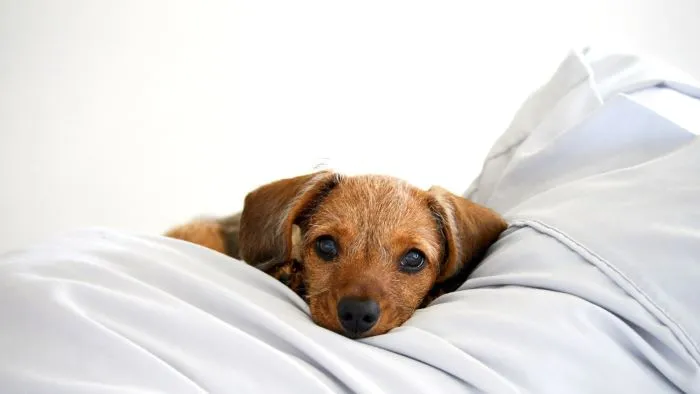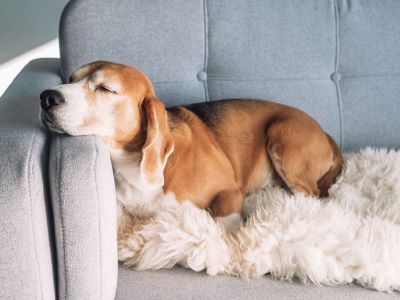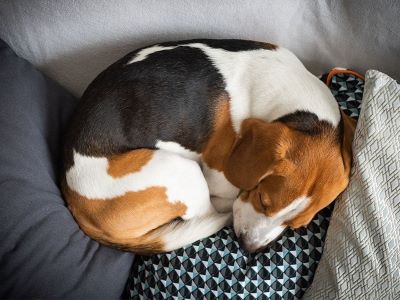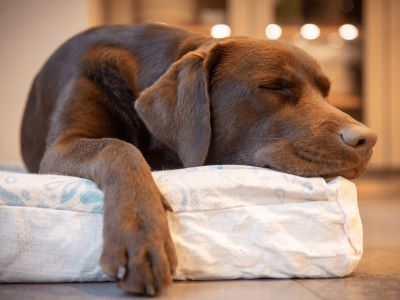Do you ever see your dog getting startled in their sleep?💤 There is no need for worry or woe, these are just sleep twitches. But “Why do dogs twitch in their sleep?”
Imagine if dogs could talk,🐶 they might say, “Hey, I had the craziest dream last night, I was chasing a squirrel up a tree!” These twitches are like a sneak peek into their dream world.🔮
So let’s find out if this is just their slumber party or if something serious is going on. Our quest starts from here.

Why Do Dogs Twitch in Their Sleep?
When humans dream, we move around a bit, but our muscles are mostly still. Dogs, on the other paw, have a different deal. When they’re in REM(Rapid Eye Movement) sleep, their brains🧠 are super active, like they’re at a dream party, but their muscles take a time-out.
This muscle stillness is like a safety net to keep them from acting out their dreams, which could be chasing a squirrel,🐿️ playing fetch, or even meeting their doggie friends. They might be running, wagging their tails, or even barking in their dream adventures.
In the REM phase, a dog’s eyes move behind closed lids, and their big muscles are like ‘off’ switches, so they don’t physically act out their dreams. It’s like their brain is having a movie night while their body takes a break. So, when you see your dog twitching, it’s like a sneak peek into their dream world.

But, there’s a serious side too. If your dog twitches excessively or in strange ways, it could be a sign of a health issue.🛑 It’s like a warning signal that something might be wrong, such as a sleep disorder or some other medical problem.
“Dogs sleep for about 12-14 hours a day,⏳ the twitches you see in their sleep usually happen during the dreamy part of their snooze. Dogs go through similar dream stages as humans, including non-rapid eye movement (NREM), short-wave sleep (SWS), and rapid eye movement (REM)“, confirms Taresa Manucy from PetMD.
Common Types of Twitches
Let’s see some types of twitches:
Muscle Twitching
Muscle twitching is when you see your dog’s muscles spasm or jerk during sleep.💤 It’s like a tiny dance that their muscles do, often in their legs or face.
These twitches can be so subtle that they might just make your pup’s skin ripple a bit, or they could be more pronounced, causing a leg to move. Muscle💪 twitching in dogs during sleep is usually connected to their dreams[1].
When they’re in the REM (rapid eye movement) phase of sleep, it’s like they’re in the most exciting part of their dream,🔮 which can lead to these muscle twitches. It’s kind of like when you might flinch in your sleep if you dream of falling.

Paddling and Running Movements
Paddling and running movements are when your dog’s legs make motions like they’re swimming or running.🏃♂️ It can look like they’re chasing something or maybe having a playful romp.
These actions often indicate that your dog is in a happy dream. It’s like they’re having a grand adventure in their sleep, and their legs are following along.
Vocalization and Whimpering
Sometimes, your dog might make sounds like barks, whines, or even little yips while sleeping. These vocalizations can be quite similar to the sounds they make when they’re awake. These vocalizations might be linked to the emotions your dog is experiencing in their dreams.
They could be dreaming of playing with a friend or maybe even chasing a squirrel. So, these sounds are like a window🪟 into their dream world, revealing what’s going on in their imagination.
Sleep Twitching vs. Seizures
Let’s see a table that distinguishes Sleep Twitching from Seizures:
| Sleep Twitches | Seizures |
| Gentle, rhythmic movements. | Stiffening, violent twitching, or convulsions. |
| Often in legs or face. | Uncontrollable, intense movements. |
| Happens during dreams. | Resemble an unplanned dance party. |
| Often in the legs or face. |

How to Improve Your Dog’s Sleep
Selecting a comfortable and supportive bed for your dog is essential. Consider factors like their size, age, and any specific needs they may have, such as orthopaedic beds🛏️ for senior dogs. A well-suited bed can promote better sleep quality and overall comfort.
Dogs are sensitive to temperature changes. Ensure that the room is at a comfortable temperature for your dog’s breed and size. Too hot or too cold🧊 conditions can disrupt their sleep.
Reducing Disturbances During Sleep
Dogs, like humans, need a peaceful sleep environment. Reducing loud noises and minimizing exposure to bright lights during their sleep hours can help your dog sleep soundly.
Establishing a routine for your dog’s sleep💤 can be incredibly beneficial. Dogs thrive on consistency, so try to feed them and take them for walks at the same times daily, and make their sleep schedule a part of this routine.
Providing Physical and Mental Stimulation
Regular physical activity is essential for your dog’s overall health and sleep quality. Take them for walks, play fetch, or engage in other fun activities that help them expend energy. A tired dog is more likely to have a restful sleep.
Mental stimulation🧠 is as crucial as physical exercise. Interactive toys, puzzles, and training sessions challenge your dog’s mind, which can prevent boredom and anxiety that might affect their sleep[2].

Nutritional Considerations for Better Sleep
Feeding your dog a balanced diet is important. Ensure their meals are not too close to bedtime to avoid discomfort. Consider their specific dietary needs, whether they require a special diet for allergies, sensitivities, or age-related issues.
As dogs age, their sleep patterns may change. Older dogs might experience restlessness or wake up during the night.🌃 Consult your vet for guidance on dietary adjustments or supplements that can improve their sleep quality.
FAQs
❔Signs of Dog Seizure While Sleeping?
Symptoms can include collapsing, jerking, stiffening, muscle twitching, loss of consciousness, drooling, chomping, tongue chewing, or foaming at the mouth. Dogs can fall to the side and make paddling motions with their legs. They sometimes poop or pee during the seizure. They are also not aware of their surroundings.
❔Why Do Dogs Twitch in Their Sleep?
While they sleep, a dog’s brain processes information and experiences from the day through dreams. Twitching is often related to active dream cycles in the brain. According to research by psychologist Stanley Coren, an average-size dog will dream about every 20 minutes, and these dreams will last about a minute.
❔Is It Normal for Dogs to Twitch and Cry in Their Sleep?
Even though science shows that there are similarities in brain patterns during REM sleep similar to humans, it still does not prove that a dog is dreaming. According to him, it is not an uncommon thing for dogs to twitch or even cry out during REM sleep.
Summary
Understanding why dogs twitch in their sleep is an important part of being a pet parent. So, next time you wonder “Why do dogs twitch in their sleep?“💤
Remind yourself that sleep twitches are generally harmless, but it’s beneficial to know what causes this common phenomenon. It’s like when humans kick their legs or move their fingers in dreams.
With our love and care, we can listen to our dogs even when they can’t speak. So, keep loving💖 and learning!
References:
- Burke, A. (2023). Why do dogs twitch in their sleep? American Kennel Club.
- Brain games: Mental stimulation keeps dogs’ minds sharp. WebMD.



